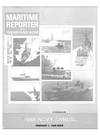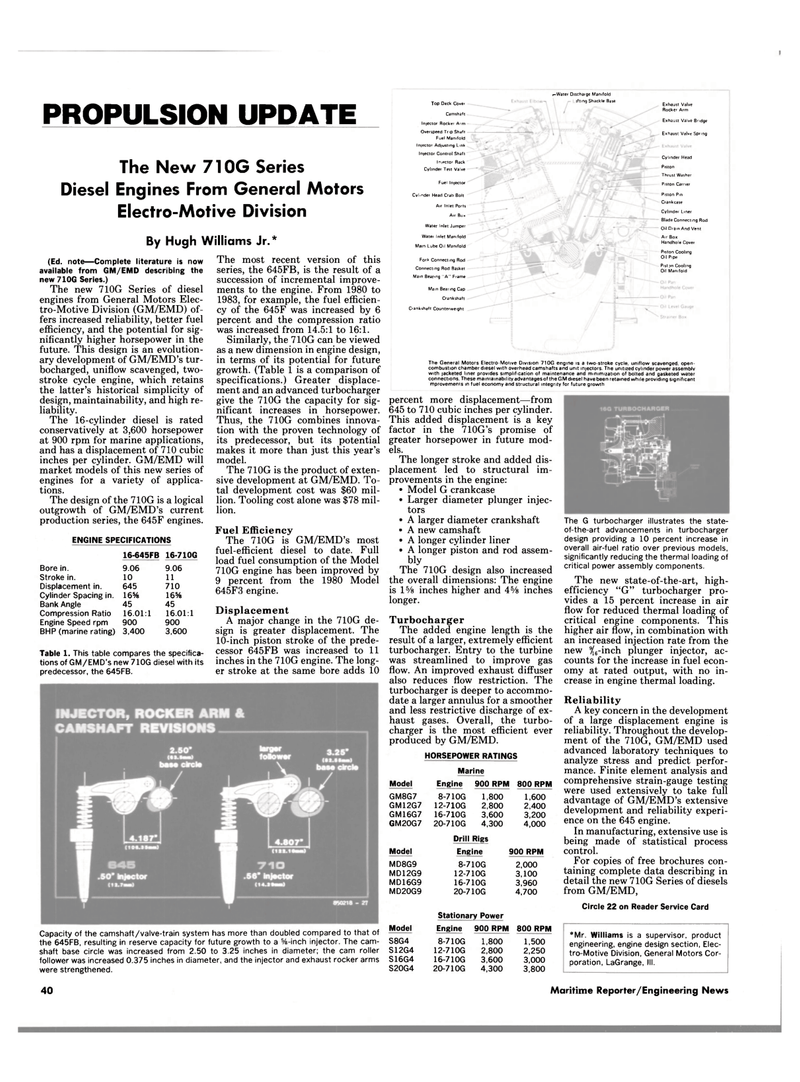
Page 38: of Maritime Reporter Magazine (February 1986)
Read this page in Pdf, Flash or Html5 edition of February 1986 Maritime Reporter Magazine
PROPULSION UPDATE
The New 710G Series
Diesel Engines From General Motors
Electro-Motive Division
By Hugh Williams Jr.* (Ed. note—Complete literature is now available from GM/EMD describing the new 710G Series.)
The new 710G Series of diesel engines from General Motors Elec- tro-Motive Division (GM/EMD) of- fers increased reliability, better fuel efficiency, and the potential for sig- nificantly higher horsepower in the future. This design is an evolution- ary development of GM/EMD's tur- bocharged, uniflow scavenged, two- stroke cycle engine, which retains the latter's historical simplicity of design, maintainability, and high re- liability.
The 16-cylinder diesel is rated conservatively at 3,600 horsepower at 900 rpm for marine applications, and has a displacement of 710 cubic inches per cylinder. GM/EMD will market models of this new series of engines for a variety of applica- tions.
The design of the 710G is a logical outgrowth of GM/EMD's current production series, the 645F engines.
ENGINE SPECIFICATIONS 16-645FB 16-710G
Bore in. 9.06 9.06
Stroke in. 10 11
Displacement in. 645 710
Cylinder Spacing in. 16% 16%
Bank Angle 45 45
Compression Ratio 16.01:1 16.01:1
Engine Speed rpm 900 900
BHP (marine rating) 3,400 3,600
Table 1. This table compares the specifica- tions of GM/EMD's new 710G diesel with its predecessor, the 645FB.
The most recent version of this series, the 645FB, is the result of a succession of incremental improve- ments to the engine. From 1980 to 1983, for example, the fuel efficien- cy of the 645F was increased by 6 percent and the compression ratio was increased from 14.5:1 to 16:1.
Similarly, the 710G can be viewed as a new dimension in engine design, in terms of its potential for future growth. (Table 1 is a comparison of specifications.) Greater displace- ment and an advanced turbocharger give the 710G the capacity for sig- nificant increases in horsepower.
Thus, the 710G combines innova- tion with the proven technology of its predecessor, but its potential makes it more than just this year's model.
The 710G is the product of exten- sive development at GM/EMD. To- tal development cost was $60 mil- lion. Tooling cost alone was $78 mil- lion.
Fuel Efficiency
The 710G is GM/EMD's most fuel-efficient diesel to date. Full load fuel consumption of the Model 710G engine has been improved by 9 percent from the 1980 Model 645F3 engine.
Displacement
A major change in the 710G de- sign is greater displacement. The 10-inch piston stroke of the prede- cessor 645FB was increased to 11 inches in the 710G engine. The long- er stroke at the same bore adds 10
Capacity of the camshaft/valve-train system has more than doubled compared to that of the 645FB, resulting in reserve capacity for future growth to a %-inch injector. The cam- shaft base circle was increased from 2.50 to 3.25 inches in diameter; the cam roller follower was increased 0.375 inches in diameter, and the injector and exhaust rocker arms were strengthened.
Marine
Model
GM8G7
GM12G7
GM16G7
GM20G7
Model
MD8G9
MD12G9
MD16G9
MD20G9
Model
S8G4
S12G4
S16G4
S20G4
Engine 8-710G 12-710G 16-710G 20-710G 900 RPM 800 RPM 1,800 2,800 3,600 4,300 1,600 2,400 3,200 4,000
Drill Rigs
Engine 8-710G 12-710G 16-710G 20-710G
Stationary Power
Engine 8-710G 12-710G 16-710G 20-710G 900 RPM 2,000 3,100 3,960 4,700 900 RPM 800 RPM percent more displacement—from 645 to 710 cubic inches per cylinder.
This added displacement is a key factor in the 710G's promise of greater horsepower in future mod- els.
The longer stroke and added dis- placement led to structural im- provements in the engine: • Model G crankcase • Larger diameter plunger injec- tors • A larger diameter crankshaft • A new camshaft • A longer cylinder liner • A longer piston and rod assem- bly
The 710G design also increased the overall dimensions: The engine is lVs inches higher and 4% inches longer.
Turbocharger
The added engine length is the result of a larger, extremely efficient turbocharger. Entry to the turbine was streamlined to improve gas flow. An improved exhaust diffuser also reduces flow restriction. The turbocharger is deeper to accommo- date a larger annulus for a smoother and less restrictive discharge of ex- haust gases. Overall, the turbo- charger is the most efficient ever produced by GM/EMD.
HORSEPOWER RATINGS
The G turbocharger illustrates the state- of-the-art advancements in turbocharger design providing a 10 percent increase in overall air-fuel ratio over previous models, significantly reducing the thermal loading of critical power assembly components.
The new state-of-the-art, high- efficiency "G" turbocharger pro- vides a 15 percent increase in air flow for reduced thermal loading of critical engine components. This higher air flow, in combination with an increased injection rate from the new 9/6-inch plunger injector, ac- counts for the increase in fuel econ- omy at rated output, with no in- crease in engine thermal loading.
Reliability
A key concern in the development of a large displacement engine is reliability. Throughout the develop- ment of the 710G, GM/EMD used advanced laboratory techniques to analyze stress and predict perfor- mance. Finite element analysis and comprehensive strain-gauge testing were used extensively to take full advantage of GM/EMD's extensive development and reliability experi- ence on the 645 engine.
In manufacturing, extensive use is being made of statistical process control.
For copies of free brochures con-taining complete data describing in detail the new 710G Series of diesels from GM/EMD,
Circle 22 on Reader Service Card 1,800 2,800 3,600 4,300 1,500 2,250 3,000 3,800 *Mr. Williams is a supervisor, product engineering, engine design section, Elec- tro-Motive Division, General Motors Cor- poration, LaGrange, III.
The General Motors Electro-Motive Division 710G engine is a two-stroke cycle, uniflow scavenged, open- combustion chamber diesel with overhead camshafts and unit injectors The unitized cylinder power assembly with jacketed liner provides simplification of maintenance and minimization of bolted and gasketed water connections These maintainability advantages of the GM diesel have been retained while providing significant mprovements in fuel economy and structural integrity for future growth
Top Deck Cover
Camshaft
Injector Rocker Arm
Overspeed Tr ip Shaft
Fuel Manifold ln|ector Adjusting Link
Injector Control Shaft
I n lector Rack
Cylinder Test Valve
Fuel Injector
Cvl-nder Heart Crab Bolt
A,r Inlet Ports
Air Bn.
Water Inlet Jumper
Water Inlet Manifold
Main Lube Oil Man fold
Forlr Connecting Rod
Connecting Rod Basket
Mam Bearing "A" Frame
Main Beaimg Cap
Crankshaft
Crankshaft Counterweight
Exhaust Valve Bridge
Exhaust Valve Spring
Cylinder Head
Piston
Thrust Washer
Piston Carrier
Piston Pin
Crankcase
Cylinder Liner
Blade Connecting Rod
OH Drain And Vent
Air Box
Handhole Cover
Prston Cooling
Oil Pipe
Piston Cooling
OH Manifold ,-Water Dischaige Manifold if11ng Shact le Base Exhaust Valve
Rocker Arm 40 Maritime Reporter/Engineering News

 37
37

 39
39
